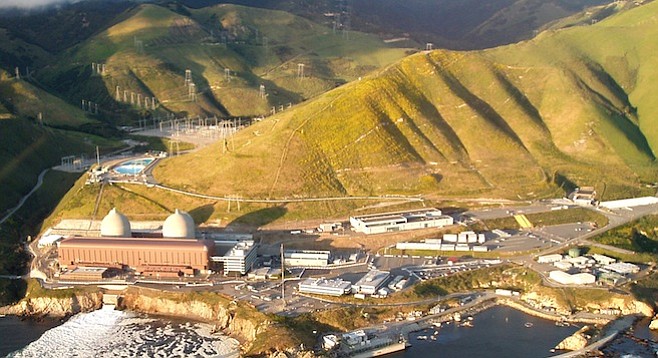 Facebook
Facebook
 X
X
 Instagram
Instagram
 TikTok
TikTok
 Youtube
Youtube

Environmentalist collective Friends of the Earth, one of several groups that played a significant role in pushing for the permanent shutdown of the San Onofre Nuclear Generating Station, is asking a federal judge to order operations ceased at Diablo Canyon, the state's last remaining nuclear plant.
In a federal court filing last week, the organization alleges that plant operator Pacific Gas & Electric and the Nuclear Regulatory Commission dodged rules in allowing an update to the plant's safety plan to go forward without public hearings.
At issue are questions pertaining to earthquake safety at the plant, which have existed since before ground broke on the project in 1968 and have intensified following Japan's Fukushima Daiichi disaster in 2011. Additionally, a new earthquake fault line has been discovered in recent years, extending as close as 650 feet from the plant. In the wake of Fukushima's meltdowns, former Diablo Canyon senior resident inspector Dr. Michael Peck penned an opinion that the plant was operating in violation of its federal license and should be shut down until new seismic concerns could be addressed.
"In a July 2013 formal dissent, which the NRC suppressed for more than a year, Dr. Peck argued that newly discovered faults could produce earthquakes far more destructive than the plant was designed, built and licensed to withstand," the organization claims in a statement announcing their complaint.
Instead of studying how the new fault lines could affect the facility, the complaint alleges that PG&E and the Commission quietly agreed to revise the existing license to relax earthquake-safety compliance. Any such change to the license should have been subject to full public review.
“At Diablo, it is now clear that these outdated 1960s-era reactors are not built to withstand the earthquake risks that surround the plant,” warned Damon Moglen, a strategic advisor with Friends of the Earth. "This plant is arguably the most at-risk plant in America."
For its part, PG&E says it has studied the new Shoreline fault extensively and found it to be less threatening than the Hosgri fault line, which caused issues and massive cost overruns as engineers grappled to address its threats in the 1960s. The Nuclear Regulatory Commission has thus far declined to comment.


Environmentalist collective Friends of the Earth, one of several groups that played a significant role in pushing for the permanent shutdown of the San Onofre Nuclear Generating Station, is asking a federal judge to order operations ceased at Diablo Canyon, the state's last remaining nuclear plant.
In a federal court filing last week, the organization alleges that plant operator Pacific Gas & Electric and the Nuclear Regulatory Commission dodged rules in allowing an update to the plant's safety plan to go forward without public hearings.
At issue are questions pertaining to earthquake safety at the plant, which have existed since before ground broke on the project in 1968 and have intensified following Japan's Fukushima Daiichi disaster in 2011. Additionally, a new earthquake fault line has been discovered in recent years, extending as close as 650 feet from the plant. In the wake of Fukushima's meltdowns, former Diablo Canyon senior resident inspector Dr. Michael Peck penned an opinion that the plant was operating in violation of its federal license and should be shut down until new seismic concerns could be addressed.
"In a July 2013 formal dissent, which the NRC suppressed for more than a year, Dr. Peck argued that newly discovered faults could produce earthquakes far more destructive than the plant was designed, built and licensed to withstand," the organization claims in a statement announcing their complaint.
Instead of studying how the new fault lines could affect the facility, the complaint alleges that PG&E and the Commission quietly agreed to revise the existing license to relax earthquake-safety compliance. Any such change to the license should have been subject to full public review.
“At Diablo, it is now clear that these outdated 1960s-era reactors are not built to withstand the earthquake risks that surround the plant,” warned Damon Moglen, a strategic advisor with Friends of the Earth. "This plant is arguably the most at-risk plant in America."
For its part, PG&E says it has studied the new Shoreline fault extensively and found it to be less threatening than the Hosgri fault line, which caused issues and massive cost overruns as engineers grappled to address its threats in the 1960s. The Nuclear Regulatory Commission has thus far declined to comment.
Comments